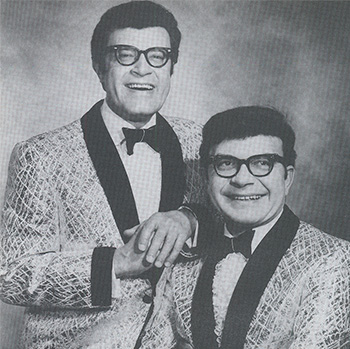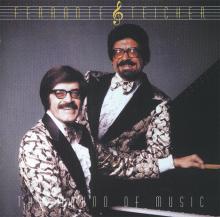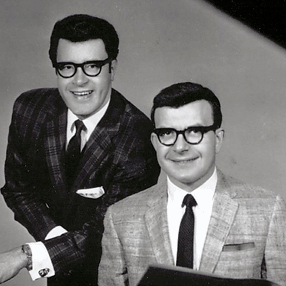The Sound of Music
- George M. Cohan Medley (Yankee Doodle Dandy, Harrigan, You're A Grand Old Flag, Mary's A Grand Old Name, Give My Regards To Broadway, Over There)
- Feelings
- Pareei
- Simon & Garfunkel Medley (Sounds Of Silence, 59th Street Bridge Song (Feelin' Groovy), Scarborough Fair-Canticle, Mrs. Robinson)
- St. Louis Blues
- Jungle Fever
- The Sound Of Music Overture
- Tiger Rag
- Slaughter On Tenth Avenue
- Tico Tico
- Reverie
- Stephen Foster Fantasy (I Dream Of Jeanie, Old Black Joe, Swanee River, Oh Susanna, Camptown Races)
Produced by Scott W. Smith and Ferrante & Teicher
Arranged by Ferrante & Teicher
Tracks 6 and 10: Prepared pianos by Ferrante & Teicher
Collection Produced by Cary E. Mansfield
Remix by Scott W. Smith
Recorded at A&M Studios – Hollywood, CA, Criteria Sound – Miami, FL and National Sonds, NYC
Recording Engineers: Hank Cicalo, Mack Emerman & Frank Kulag
Mastering supervision and tape research by Marty Wekser
Digitally Remastered by Jim Phillips at Universal Mastering West, North Hollywood, CA
Notes by Joseph Lanza
Photos courtesy of The Scott W. Smith Collection
Art Direction & Design by Bill Pitzonka
Special thanks to Ferrante & Teicher, Dick Bartley, Dave Booth, Marty Boratyn, Pat Downey, Kevin Elliott, Brian Giorgi, Pete Howard, Bill Inglot, Steve Knapp, Steve Kolanjian, Paul Lichtenstein, Kim Mansfield, Stephanie J. Mansfield, Steve Massie, Andy McKaie, Jerry Osborne, Mike Palesh, Clay Pasternack, Mike Ragogna, Jerry Reuss, Dan Richardson, David Sanjek (BMI Archives), Andrea Sine
CD: Varése Sarabande 302 066 158 2
(Avante-Garde AVG-1007)
 By the dawn of the sixties, a rising generation of record-buyers was succumbing to the palpitations of rock n’roll and the Twist, so how could two natty Juilliard alumni in black horn-rimmed glasses hope to woo America just by tickling the ivories? That question got an immediate answer in 1960, following the extremely successful release of their “Theme from The Apartment.” These already seasoned stage veterans underwent a major career shif: their concerts stated selling out practically overnight, they looked forward to several Top 40 hits, and many of their fans turned out to be teenage girls!
By the dawn of the sixties, a rising generation of record-buyers was succumbing to the palpitations of rock n’roll and the Twist, so how could two natty Juilliard alumni in black horn-rimmed glasses hope to woo America just by tickling the ivories? That question got an immediate answer in 1960, following the extremely successful release of their “Theme from The Apartment.” These already seasoned stage veterans underwent a major career shif: their concerts stated selling out practically overnight, they looked forward to several Top 40 hits, and many of their fans turned out to be teenage girls!
Soon, Ferrante & Teicher were preeminent pop radio stars who went from being mere “duo-pianists” to a resplendent “two-man show.” They serenaded the world with the greatest romantic ballads, and the zaniest of novelty numbers. In the twenty years (1959-1979) that they recorded for United Artists Records, their signature sound included a full orchestra, with strings, horns, voices, and their two nine-foot concert grands.
Ferrante & Teicher maintained another life, however. They continued as concert performers who kept thousands enthralled with their solo pianos. According to Scott Smith, their anecdote-enriched personal manager: “Every night after a performance, they would have between 200 and 300 people backstage wanting autographs. Many would ask, ‘Why can’t we buy your records just as we heard you tonight – without your orchestra?’”
By the early eighties, once they had left United Artists, Ferrante & Teicher decided to honor this backstage request with several recordings capturing the sonic simplicity they exhibited onstage. This collection highlights these sessions. It includes some of their prized encore medleys; each sequenced to recreate the mood of their public extravaganzas. From the moment the encore starts with the “George M. Cohan Medley,” they established the festive spirit of a tried-and-true pops concert. (From time to time, they would even be Arthur Fiedler’s special guests with the legendary Boston Pops.)
This collection also typifies Ferrante & Teicher’s penchant for tuneful time travel. They take us back to the pre-Civil War days on the “Stephen Foster Fantasy,” contrasting the raucous minstrel songs like “Camptown Races” and “Oh, Susannah” with the tender romantic melodies like “Jeanie With The Light Brown Hair” that the composer himself preferred but for which he is unfortunately less remembered. Flash-forwarding a century, they pay their double-grand tribute to Rodgers and Hammerstein on “The Sound of Music Overture.” The “Simon & Garfunkel Medley” veers from Tin Pan Alley standards to the “new classics” of this mid-to-late sixties, offering a melodic bridge over what was once a troubled “generation gap.” The delicate handling of Morris Albert’s “Feelings” represents Ferrante & Teicher’s more subdued mid-seventies period, when many of their recordings were featured on the now greatly missed “Beautiful Music” radio formats.
On the more exotic side, there are “Tico Tico” and “Jungle Fever,” the latter being one of Ferrante & Teicher’s own compositions from their post-Juilliard “prepared piano” phase. Many familiar with their stately ballad interpretations might be shocked to hear some of the experimental, often nonsensical, recordings they made during these first studio years. At the opening of their October 1947 debut tour in Toledo, Ohio, they proceeded with an orderly classical regimen, but when it came time to perform Ravel’s BOLERO, they decided to get mischievous with the piece’s incessant G-note. According to Smith: “They got bored with the repetitive piano sound and stuck a rubber mute in the strings to give the g-note a drum effect. They did not even know who John Cage was when they came up with this!”
Though their adaptation of Debussy’s “Reverie” sounds very lyrical here, Ferrante & Teicher were much less reverent during the live shows. For this special number, they spiked the reel-to-reel tape, usually installed to provide sound effects through the public address systems, with parodies of their private thoughts. The tape would include such comically banal lines as: “Gee, these pants are tight!” and “I’ll be I’m wearing his pants!”
The banter would get even stranger with Ferrante saying: “I enjoy playing this number — I could play it all night long — it always gets such applause!” Teicher would then counter with: “If I have to play this number one more time, I’ll fall asleep — I don’t know why we do it anyway — it NEVER gets much applause — and I won’t be able to stand up to take my bow anyway—in these TIGHT pants — sure hope I don’t rip them!” This madcap badinage would transpire for up to five minutes, leaving the fans giggling and the renowned French composer probably cringing under his headstone.
With their blend of virtuosity and good natured horseplay, Ferrante & Teicher may have twitted some purists, but they satisfied the music-loving masses with evenings of entertainment and a fun-filled musical education. When asked why they chose a more pop direction, Ferrante would answer rhetorically: “Which would you rather do? Perform in a church for 300 people while playing the classics? Or would you rather perform at Atlanta Constitution Hall with roughly 6000 people at standing room only?” It is, therefore, with equal parts Americana, classical, romance, humor — and a few dashes of madness — that Ferrante & Teicher commemorate their art of the fourhanded rhapsody.
— Joseph Lanza
Joseph Lanza is the author of Elevator Music: A Surreal History of Muzak Easy-Listening and Other Moodsong (St. Martin’s Press/Picador)

